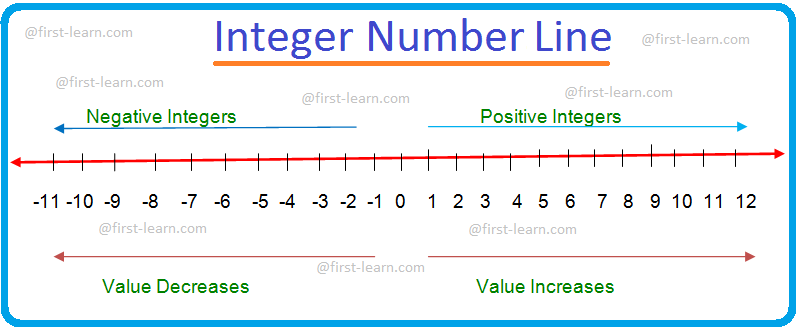Integers
Integers are similar to whole numbers but they include negative numbers and just like whole numbers do not include any fractional part in them. Integers are represented with capital letter (Z) it is denotes Zahlen German word. Integers include positive numbers (without fractional part), negative numbers (without fractional part) and zero.
Integers can be represented as = {…....... -8, -7, -6, -5, -4, -3, -2, -1, 0, 1, 2, 3, 4, 5, 6, 7, 8 ……..}
Therefore -8, -7, -6, -5, -4, -3, -2, -1, are negative integers and positive integers include 1, 2, 3, 4, 5, 6, 7, 8. 0 is a neutral integer that is neither positive nor negative.
Whereas, other numbers like \(\frac{3}{7}\), √5, (\frac{17}{9}\) are not integers.
Integers can be represented with the help of a number line:
Properties of Integers:
Note: p, q and r are integers and q is a non-zero integer
Commutative property of integers
If we change the order of integer in addition the result remains unchanged
p + q = q + p
If we change the order of integer in subtraction the result changes
p – q ≠ q – p
If we change the order of integers in multiplication the result remains unchanged
p × q = q × p
If we change the order of integers in division the result changes
p ÷ q ≠ q ÷ p
Closure Property of integers
If we add two integers the result is an integer
p + q is an integer
If we subtract two integers the result is an integer
p – q is an integer
If we multiply two integer the result is an integer
p × q is an integer
If we divide two integer the result is necessarily not an integer
p ÷ q is necessarily not an integer.
Associative Property of Integers
If we change the grouping of integers in addition the result remains unchanged
(p +q) + r = p + (q +r)
If we change the grouping of integers in subtraction the result changes
(p –q) –r ≠ p – (q – r)
If we change the grouping of integers in multiplication the result remains unchanged
(p × q) × r = p × (q × r)
If we change the grouping of integers in division the result changes
(p ÷ q) ÷ r ≠ p ÷ (q ÷ r)
Distributive Property of Integers over Addition
In this property the integers are first added and then multiplied or first multiplied then added
p × (q + r) = p × q + p × r
Distributive Property of Integers over Subtraction
In this property the integers are first subtracted and then multiplied or first multiplied then subtracted.
p × (q - r) = p × q - p × r
Identity Property of Integers
This property states that if zero is added to any integer the result is the integer itself.
Additive identity = 0
p + 0 = p
This property also states that if zero is multiplied to any integer the result is zero and if 1 is multiplied with any integer the result is the integer itself. Moreover, if an integer is multiplied with -1 the result will be an integer itself but with an opposite sign.
Multiplicative identity = 1
p × 1 =p
p × 0 = p
Recent Articles
-
What Is Plasma? | Blood Plasma | Proteins | Nutrients | Cholesterol
Nov 07, 25 10:29 AM
Blood is a mobile fluid which is a connective tissue and is derived from the mesoderm like cell any other connective tissue. Colour of blood is reddish and that flows inside the blood vessels by means… -
Disorders of Respiratory System | Tuberculosis | Pleurisy | Emphysema
Oct 28, 25 11:39 PM
Tuberculosis is very common disease and is caused by a type of bacteria called Mycobacterium tuberculosis. This disease causes different trouble in the respiration and infection of several parts of th… -
Regulation of Respiration | Respiratory Centres | Inspiratory Area |
Oct 14, 25 12:13 AM
Respiratory Centre is the area that controls the rate of respiration and it is observed to be located in medulla oblongata and pons. Respiratory Centre has the following will dispersed components like… -
Explain Transport of Gases | External Respiration | Tissue Respiration
Oct 09, 25 11:35 PM
In humans gaseous exchange is completed in the following ways the steps are - External Respiration or Breathing - Breathing in false taking in of Oxygen and giving out of carbon dioxide in the body. M… -
Kind and Number of Teeth | Location of Teeth in Mouth | Care of Teeth
Sep 11, 25 12:52 AM
Kind and Number of Teeth






New! Comments
Have your say about what you just read! Leave me a comment in the box below.